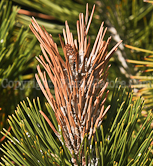|
 |
|
 |
|
 |
|
 |
 |

Austrian (Pinus
nigra)
and Scotch (Pinus
sylvestris) pines have been planted widely throughout the
Midwest for decades. Mugo (Pinus
mugo) pines have been frequently
used in home landscapes.
In recent years, these trees have been suffering
severely from a "tip blight" caused by the fungus,
Diplodia pinea (also known as Sphaeropsis
sapinea). Since so many of these non-native
species have been planted, the problem has now reached
"epidemic proportions" since the trees are reaching a
mature stage where they are very susceptible to the
disease.
Red pines are less susceptible unless planted in dense
stands where air movement is limited. White pines are
virtually immune to the disease.
|
 |
|
 |
 |
The fungus over-winters on dead needles, bark and cones.
In the spring, rain spreads the spores to swollen buds
and emerging shoots. Toward late June to July, infected
needles on the tips of the branches turn brown.
Over years, the disease progresses and kills more of the
new growth each year. In time, entire branches die and
the tree itself loses vigor.
|
 |
 |
 |
As with all fungal
diseases, diplodia tip blight is encouraged by
keeping plant tissue moist for long periods of time.
So, trees that are given enough room to grow
properly may be bothered less because they have good
air flow around the plant. This allows needles to
dry off more rapidly after rain.
Another way to help
prevent the disease is to keep the tree otherwise as
healthy and vigorous as possible. Avoid water
stress, insect infestations, mechanical damage or
other stresses.
In some instances, it
helps to prune off and destroy the first twigs that
are infested. Be sure to prune when the needles are
dry to avoid spreading the spores from branch to
branch. You can also try to knock off infected
needles and thoroughly rake them off the ground near
the tree.
|
 |
 |
 |
There are no known biological controls. Cultural
management by pruning infected branches and maintaining
good vigor by proper fertilizing and watering will help
aesthetically but will not cure the plant.
Currently, the only effective control is a
fungicide
treatment. While there are several fungicides labeled
for use on Diplodia, the benzimidazole class tend to
work best.
Bordeaux mix is also effective. It may be abrasive to
spray equipment but people have reported good results.
The timing of applications is absolutely critical!
Sprays should be applied according to label rates at or
slightly before bud break. Failure to protect the
swollen buds and emerging shoots during the rainy
infection period could lead to severe shoot loss and
make subsequent treatments useless.
Depending on the weather, species of tree and genetic
variability, the optimum time for the first spray may
vary from early April to early May. For high value
trees, three to four applications at 10 to 14 day
intervals may be needed to provide good control.
It is better to get the first spray on a little early
than to be a little late. Low value trees may be helped
by as few as two sprays.
Patience Is a Virtue: Severely infected trees have been brought back to good
health with sufficient effort and patience. However, it
may take several years of spraying and quality
maintenance to show results.
|
|
 |
|
Note: We
have provided some general information and
observations on this topic aimed at the home
gardener. Before you take
any serious action in your landscape, check
with your state's land grant university's
Cooperative
Extension
Service for the most current,
appropriate, localized recommendations. |
|
 |
 |

|
New Plantings:
The best approach to avoiding future problems is to
plant resistant types of pines. Native species have far
fewer problems than exotics such as Austrian and Scotch
pines. Red pine is somewhat less susceptible and the
white pine is practically immune.
Whatever you plant, be sure to leave plenty of room for
the mature size of the tree. Crowding is a major factor
in severity of diseases in later years. If you need a
dense planting, put the young trees close together but
be sure to thin them out over the years to allow for
proper spacing and air circulation.
|
|
Some pines susceptible to diplodla tip blight: |
|
|
 |



